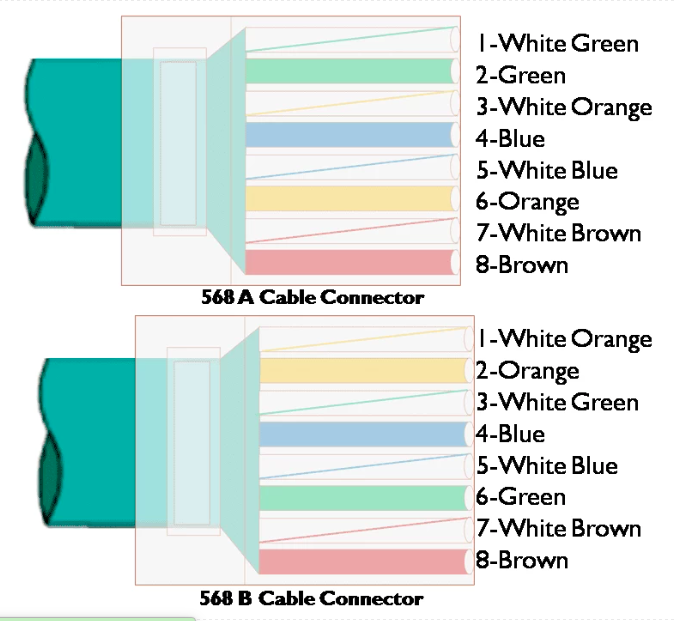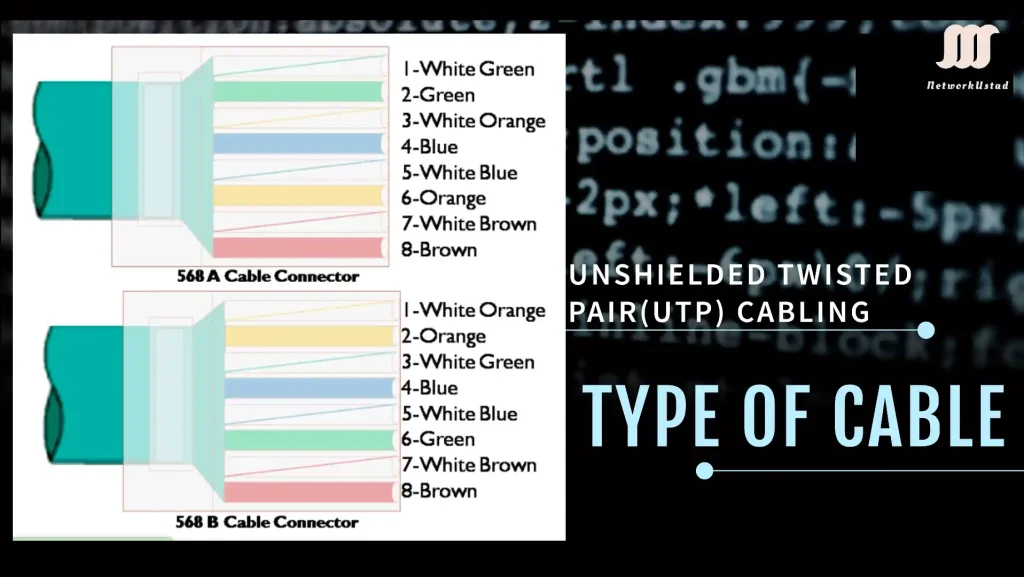Unshielded Twisted Pair (UTP) cabling remains a cornerstone of modern networking, powering Ethernet and telephone systems worldwide. As a lightweight, cost-effective solution, UTP has evolved to meet the demands of 2025’s high-speed networks, including 5G and IoT. Updated by NetworkUstad, this comprehensive guide explores UTP’s structure, categories, installation techniques, and future trends, crafted by CCNP and CCNA-certified expert Asad Ijaz Khattak. Whether you’re setting up a home network or managing a data center, this article equips you with the knowledge to excel.
What is Unshielded Twisted Pair (UTP) Cabling?
Unshielded twisted pair (UTP) cables are widely used in the computer network and the telecommunications industry as Ethernet cables and telephone wires. Unshielded twisted-pair (UTP) cabling consists of four color-coded copper wires twisted together and enclosed in a flexible plastic sheath. The twist of the copper cables around each other cancels electromagnetic interference (EMI) from external sources. Unshielded means no additional shielding like meshes or aluminum foil, which add bulk, is used. It is small, which is helpful during installation. Unshielded twisted-pair (UTP) cable does not use shielding to counter EMI and RFI effects. Cable designers discovered that they can limit the negative impact of crosstalk in the following ways:-
Cancellation
When two wires in an electrical circuit are placed close together, their magnetic fields are exactly opposite to each other. Thus, the two magnetic fields cancel each other out and cancel out any outside EMI and RFI signals.
Varying the several twists per wire pair
Designers vary the number of twists of each wire pair in a cable to improve the cancellation effect of paired circuit wires. UTP cable must follow precise specifications governing the number of twists or braids permitted per cable meter. Notice in the figure below that the orange/orange-white pair is twisted more than the green/green-white pair. Each colored pair is twisted a different number of times.
Standards of Unshielded Twisted Pair (UTP) Cabling
Unshielded Twisted Pair (UTP) cabling conforms to the standards recognized by the TIA/EIA. Specifically, TIA/EIA-568 stipulates the commercial cabling standards for LAN installations and is the standard most commonly used in LAN cabling. Some of the elements defined are below:-
1. Cable types
2. Cable lengths
3. Connectors
4. Cable termination
5. Methods of testing the cable
Electrical and Electronics Engineers (IEEE) defines the electrical characteristics of copper cabling. IEEE categorizes cables based on their ability to carry higher bandwidth rates. For example, Category 5 (CAT5) cable is commonly used in 100BASE-TX Fast Ethernet installations. Other Categories include Enhanced Category 5 (CAT5e) cable, Category 6 (CAT6), and Category 6a.
Cables in higher Categories support higher data rates. As new gigabit-speed Ethernet technologies are developed and adopted, CAT5e is now the minimum acceptable cable type.
CAT1 Cable
CAT1 cable is usually used for telephone wire. It does not support computer networking. The cable is not twisted and is also a single-pair cable, so it cannot cancel EMI and RFI. It supports a maximum of 1 Mbps data.
CAT2 Cable
CAT2 is a two-pair twisted-pair network cable that supports up to 4 Mbps data rates. Its maximum working length is 100 meters. CAT2 cable is also used in telephone networks.
CAT3 Cable
CAT3 is a twisted four-pair network-supported cable with up to 10 Mbps data rate. The maximum data rate of CAT3 cable is 10 Mbps. Public telephone networks also use CAT3 cable. The maximum working length of CAT3 cable is 100 meters.
CAT4 Cable
CAT4 cable has four twisted pair cables supporting up to 16 Mbps data rate and is mainly used in token ring networks. Telephone networks also use CAT4 cable for their services. The maximum working length of the cable is 100 meters.
CAT5 Cable
CAT5 cables are four pairs of twisted copper wire with more twists per inch than CAT4 and CAT3. Therefore, they can run at higher speeds. Each pair’s “twist” effect ensures that the twist of the partner cable cancels any interference in one cable. This type of wire can support computer networks and telephone traffic at speeds of up to 100 Mbps. It was a popular cable in networking.
CAT5e Cable
The more popular CAT5 wire was later replaced by the CAT5e, which provides an improved crosstalk specification and can support speeds of up to 1 Gbps.
CAT6 Cable
CAT6 wire was designed to support Gigabit Ethernet, although there are standards that allow gigabit transmission over CAT5e wire. It is similar to CAT5e wire but contains a physical separator between the four pairs to reduce electromagnetic interference further. The maximum working length to support speeds of 1 Gbps is 100 meters. The cable also supports 10 Gbps speed for lengths of up to 55 meters.
CAT6A Cable
CAT6A supports 10G speed, and it’s a higher specification of presents better immunity to crosstalk and electromagnetic interference.
CAT7/Cat8 Cable
CAT7 cable is a newer copper cable designed to support speeds of 40 Gbps at lengths of up to 100 meters. To achieve this, the cable features four individually shielded pairs plus an additional cable shield to protect the signals from crosstalk and electromagnetic interference (EMI). Due to the extremely high data rates, all components like patch panels, cords, jacks, and RJ-45 connectors must be CAT7 cable certified. CAT7 cable is usually used in Data Centers for backbone connections between servers, network switches, and storage devices.
How UTP Cabling Works
UTP reduces EMI by twisting wire pairs, with each pair handling send and receive signals in full-duplex mode. The development of LC connectors by Lucent Technologies enhanced UTP’s efficiency, supporting high-density applications. In 2025, improved insulation and shielding options will address EMI in dense network environments.
- Lucent Technologies developed LC connectors to improve the efficiency of UTP cabling.
Installation and Maintenance Best Practices
Proper installation ensures UTP performance:
- Termination: Use RJ45 connectors with a crimping tool.
- Cable Management: Avoid tight bends (minimum radius 4x cable diameter).
- Testing: Use a cable tester to check for continuity and crosstalk.
- 2025 Tip: Employ AI-driven tools to detect faults in real-time.
UTP in Modern Networks
In 2025, UTP adapts to emerging technologies:
- 5G Compatibility: Cat6a and Cat7 support 5G backhaul with reduced latency.
- IoT Integration: Handles millions of devices with Cat8’s high bandwidth.
- EMI Challenges: Enhanced twisting and optional shielding mitigate interference.
UTP vs. Shielded Twisted Pair (STP)
- UTP: Lighter, cheaper, prone to EMI, dominates LANs.
- STP: Shielded, costly, better for noisy environments.
- 2025 Trend: UTP with hybrid shielding gains traction for 5G deployments.
Common Issues and Solutions
- Crosstalk: Use higher categories (e.g., Cat6a) or proper twisting.
- Signal Loss: Limit cable length to 100m and avoid EMI sources.
- Connector Damage: Use durable LC connectors and regular maintenance.
Types of UTP cable by use
Different situations require UTP cable wiring in conjunction with other conventions. This means that the individual wires in the cable have to connect in various orders to other sets of pins in the RJ-45 connectors. The following are the main cable types using specific wiring conventions:
Ethernet Straight-through is the most common type of networking cable. A straight-through cable generally connects the host to a switch and a switch to a router.
Ethernet Crossover: A cable used to connect similar devices. For example, to connect a switch to a switch, a host to a host, or a router to a router.
Rollover: A Cisco proprietary cable connects a workstation to a router or switch console port.
Figures 3-7 show the UTP cable type, related standards, and typical applications of these cables. They also identify the individual wire pairs for the TIA-568A and TIA-568B standards.

Misusing a crossover or straight-through cable between devices may not damage them, but connectivity and communication between them will not occur. This is a standard error in the lab, and when checking device connections.
| Cable Type | Standard |
| Ethernet Straight-through | Both ends T568A, or Both ends T568B |
| Crossover | One end T568A, another end T568B |
| Rollover | Rollover Cisco proprietary |
FAQs
What is Unshielded Twisted Pair (UTP) cabling?
UTP cabling is a type of network cabling that uses pairs of twisted wires to reduce electromagnetic interference and improve signal quality.
What are the advantages of UTP cabling?
UTP cabling is cost-effective, easy to install, and widely used in various networking applications due to its flexibility and performance.
How does UTP cabling compare to Shielded Twisted Pair (STP) cabling?
UTP cabling is less expensive and easier to work with, while STP cabling provides additional shielding to reduce interference in high-noise environments.
What are common applications of UTP cabling?
UTP cabling is commonly used in local area networks (LANs), telephone systems, and data communication lines.
What should I consider when installing UTP cabling?
Consider factors like cable length, category rating, and installation environment to ensure optimal performance and reliability.





